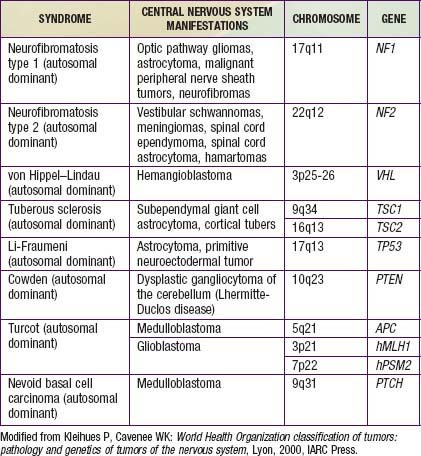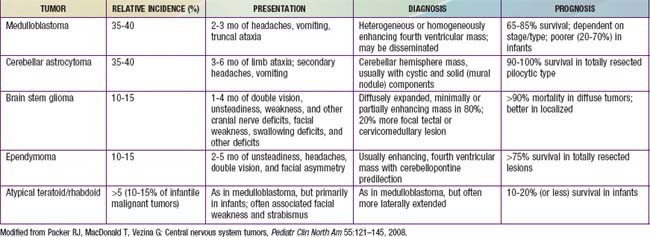Chapter 491 Brain Tumors in Childhood
Primary central nervous system (CNS) tumors are a heterogeneous group of diseases that are, collectively, the second most common malignancy in childhood and adolescence. The overall mortality among this group approaches 4.5%. Patients with CNS tumors have the highest morbidity—primarily neurologic—of all children with malignancies. Outcomes have improved over time with innovations in neurosurgery and radiation therapy as well as introduction of chemotherapy as a therapeutic modality. The treatment approach for these tumors is multimodal. Surgery with complete resection, if feasible, is the foundation, with radiation therapy and chemotherapy utilized according to the diagnosis, patient age, and other factors.
Etiology
The etiology of pediatric brain tumors is not well defined. A male predominance is noted in the incidence of medulloblastoma and ependymoma. Familial and hereditary syndromes associated with increased incidence of brain tumors account for approximately 5% of cases (Table 491-1). Cranial exposure to ionizing radiation also is associated with a higher incidence of brain tumors. There are sporadic reports of brain tumors within families without evidence of a heritable syndrome. The molecular events associated with tumorigenesis of pediatric brain tumors are not known.
Epidemiology
Approximately 3700 primary brain tumors are diagnosed each year in children and adolescents, with an overall annual incidence of approximately 45 cases/million children <20 yr of age. The incidence of CNS tumors is highest in infants and children ≤5 yr of age (approximately 52 cases/million children).
Pathogenesis
More than 100 histologic categories and subtypes of primary brain tumors are described in the World Health Organization (WHO) classification of tumors of the CNS. In children 0-14 yr, the most common tumors are pilocytic astrocytomas (PAs) and medulloblastoma/primitive neuroectodermal tumors (PNETs). In adolescents (15-19 yr), the most common tumors are pituitary tumors and PAs (Fig. 491-1).
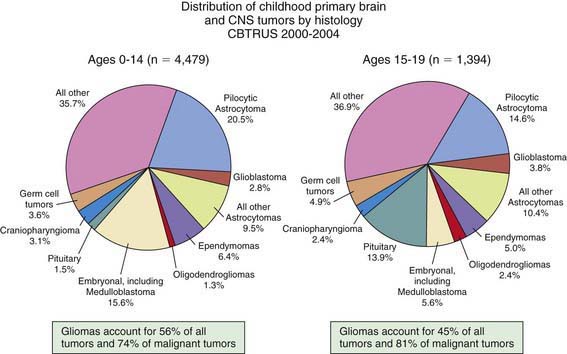
Figure 491-1 Distribution of childhood primary brain and CNS tumors by histology.
(From Central Brain Tumor Registry of the United States [CBTRUS]: CBTRUS statistical report: primary brain and central nervous system tumors diagnosed in the United States in 2004-2006: February 2010 (PDF file). www.cbtrus.org/2010-NPCR-SEER/CBTRUS-WEBREPORT-Final-3-2-10.pdf. Accessed March 19, 2011.)
The Childhood Brain Tumor Consortium reported a slight predominance of infratentorial tumor location (43.2%), followed by the supratentorial location (40.9%), spinal cord (4.9%), and multiple sites (11%) (Fig. 491-2, Table 491-2). There are age-related differences in primary location of tumor. During the first year of life, supratentorial tumors predominate and include, most commonly, choroid plexus complex tumors and teratomas. In children 1-10 yr of age, infratentorial tumors predominate, owing to the high incidence of juvenile pilocytic astrocytoma and medulloblastoma. After 10 yr of age, supratentorial tumors again predominate, with diffuse astrocytomas most common. Tumors of the optic pathway and hypothalamus region, the brainstem, and the pineal-midbrain region are more common in children and adolescents than in adults.
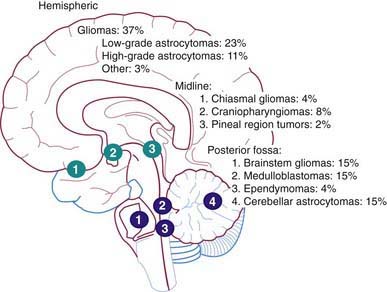
Figure 491-2 Childhood brain tumors occur at any location within the central nervous system. The relative frequency of brain tumor histologic types and the anatomic distribution are shown.
(Redrawn from Albright AL: Pediatric brain tumors, CA Cancer J Clin 43:272–288, 1993.)
Clinical Manifestations
The clinical presentation of the patient with a brain tumor depends on the tumor location, the tumor type, and the age of the child. Signs and symptoms are related to obstruction of cerebrospinal fluid (CSF) drainage paths by the tumor, leading to increased intracranial pressure (ICP) or causing focal brain dysfunction. Subtle changes in personality, mentation, and speech may precede these classic signs and symptoms; such changes often occur with supratentorial (cortical) lesions. In young children, the diagnosis of a brain tumor may be delayed because the symptoms are similar to those of more common illnesses, such as gastrointestinal disorders. Infants with open cranial sutures may present with signs of increased ICP, such as vomiting, lethargy, and irritability, as well as the later finding of macrocephaly. The classic triad headache, nausea, and vomiting as well as papilledema are associated with midline or infratentorial tumors. Disorders of equilibrium, gait, and coordination occur with infratentorial tumors. Torticollis may result in cerebellar tonsil herniation. Blurred vision, diplopia, and nystagmus also are associated with infratentorial tumors. Tumors of the brainstem region may be associated with gaze palsy, multiple cranial nerve palsies, and upper motor neuron deficits (e.g., hemiparesis, hyperreflexia, clonus). Supratentorial tumors are more commonly associated with focal disorders such as motor weaknesses, sensory changes, speech disorders, seizures, and reflex abnormalities. Infants with supratentorial tumors may present with hand preference. Optic pathway tumors manifest as visual disturbances, such as decreased visual acuity, Marcus Gunn pupil (afferent pupillary defect), nystagmus, and/or visual field defects. Suprasellar region tumors and third ventricular region tumors may manifest initially as neuroendocrine deficits, such as diabetes insipidus, galactorrhea, precocious puberty, delayed puberty, and hypothyroidism. The diencephalic syndrome, which manifests as failure to thrive, emaciation, increased appetite, and euphoric affect, occurs in infants and young children with tumors in these regions. Parinaud syndrome is seen with pineal region tumors and is manifested by paresis of upward gaze, pupillary dilation reactive to accommodation but not to light, nystagmus to convergence or retraction, and eyelid retraction. Spinal cord tumors and spinal cord dissemination of brain tumors may manifest as long nerve tract motor and/or sensory deficits, bowel and bladder deficits, and back or radicular pain. The signs and symptoms of meningeal metastatic disease from brain tumors or leukemia are similar to those of infratentorial tumors.
Diagnosis
The evaluation of a patient in whom a brain tumor is suspected is an emergency. Initial evaluation should include a complete history, physical (including ophthalmic) examination, and neurologic assessment with neuroimaging. For primary brain tumors, MRI is the neuroimaging standard. Tumors in the pituitary/suprasellar region, optic path, and infratentorium are better delineated with MRI than with CT. Patients with tumors of the midline and the pituitary/suprasellar/optic chiasmal region should undergo evaluation for neuroendocrine dysfunction. Formal ophthalmologic examination is beneficial in patients with optic path region tumors to document the impact of the disease on oculomotor function, visual acuity, and fields of vision. The suprasellar region and pineal region are preferential sites for germ cell tumors. Both serum and CSF measurements of β-human chorionic gonadotropin and α-fetoprotein can assist in the diagnosis of germ cell tumors. In tumors with a propensity for spreading to the leptomeninges, such as medulloblastoma/PNET, ependymoma, and germ cell tumors, lumbar puncture with cytologic analysis of the CSF is indicated; lumbar puncture is contraindicated in individuals with newly diagnosed hydrocephalus secondary to CSF flow obstruction, in tumors that cause supratentorial midline shift, and in individuals with infratentorial tumors. Lumbar puncture in these individuals may lead to brain herniation, resulting in neurologic compromise and death. Therefore, in children with newly diagnosed intracranial tumors and signs of increased ICP, the lumbar puncture usually is delayed until surgery or shunt placement.
Specific Tumors
Astrocytomas
Astrocytomas are a heterogeneous group of pediatric CNS tumors that account for approximately 40% of cases. These tumors occur throughout the CNS.
Low-grade astrocytomas (LGAs), the predominant group of astrocytomas in childhood, are characterized by an indolent clinical course. PA is the most common astrocytoma in children, accounting for about 20% of all brain tumors (Fig. 491-3). On the basis of clinicopathologic features using the WHO Classification System, PA is classified as a WHO grade I tumor. Although PA can occur anywhere in the CNS, the classic site is the cerebellum. Other common sites include the hypothalamic/third ventricular region and the optic nerve and chiasmal region. The classic but not exclusive neuroradiologic finding in PA is the presence of a contrast medium–enhancing nodule within the wall of a cystic mass (see Fig. 491-3). The microscopic findings include the biphasic appearance of bundles of compact fibrillary tissue interspersed with loose microcystic, spongy areas. The presence of Rosenthal fibers, which are condensed masses of glial filaments occurring in the compact areas, helps establish the diagnosis. PA has a low metastatic potential and is rarely invasive. A small proportion of these tumors can progress and develop leptomeningeal spread, particularly when they occur in the optic path region. A PA very rarely undergoes malignant transformation to a more aggressive tumor. A PA of the optic nerve and chiasmal region is a relatively common finding in patients with neurofibromatosis type 1 (15% incidence). Unlike in diffuse fibrillary astrocytomas, there are no characteristic cytogenetic abnormalities in PA nor are there any known molecular abnormalities. Other tumors occurring in the pediatric age group with clinicopathologic characteristics similar to those of PA include pleomorphic xanthoastrocytoma, desmoplastic cerebral astrocytoma of infancy, and subependymal giant cell astrocytoma.
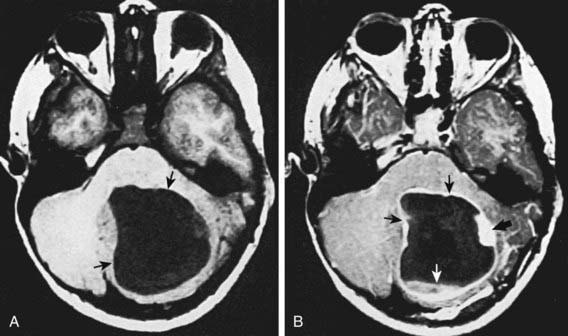
Figure 491-3 A, Axial T1-weighted MR image of a patient with cerebellar pilocytic astrocytoma, demonstrating predominantly cystic (hypointense) component (arrows) involving the left cerebellar hemisphere and vermis. B, Gadolinium-enhanced axial T1-weighted MR image in the same child demonstrates enhancement of the solid component (large arrow), enhancement of the capsule (small black arrows), and layering of contrast material (white arrow) at the bottom of the cyst.
(From Kuhn JP, Slovis TL, Haller JO: Caffey’s pediatric diagnostic imaging, ed 10, Philadelphia, 2004, Mosby, p 576.)
The second most common astrocytoma is fibrillary infiltrating astrocytoma, which consists of a group of tumors characterized by a pattern of diffuse infiltration of tumor cells among normal neural tissue and potential for anaplastic progression. On the basis of their clinicopathologic characteristics, they are grouped as low-grade astrocytomas (WHO grade II), malignant astrocytomas (anaplastic astrocytoma; WHO grade III), and glioblastoma multiforme (GBM; WHO grade IV). Of this group, the fibrillary LGA is the second most common astrocytoma in children, accounting for 15% of brain tumors. Histologically, these low-grade tumors demonstrate greater cellularity than normal brain parenchyma, with few mitotic figures, nuclear pleomorphism, and microcysts. The characteristic MRI finding is a lack of enhancement after contrast agent infusion (Fig. 491-4). Molecular genetic abnormalities found among low-grade diffuse infiltrating astrocytomas include mutations of p53 and overexpression of platelet-derived growth factor α-chain and platelet-derived growth factor receptor-α. Fibrillary infiltrating astrocytoma has the potential to evolve into malignant astrocytoma, a development that is associated with cumulative acquisition of multiple molecular abnormalities.
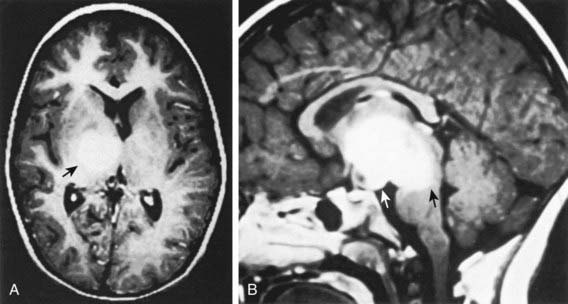
Figure 491-4 A, Gadolinium-enhanced axial T1-weighted MR image of grade III astrocytoma of the right thalamus demonstrating diffuse enhancement (arrow). B, Gadolinium-enhanced sagittal T1-weighted MR image showing enhancement of grade III astrocytoma of the thalamus with extension into the midbrain (black arrow) and hypothalamus (white arrow).
(From Kuhn JP, Slovis TL, Haller JO: Caffey’s pediatric diagnostic imaging, ed 10, Philadelphia, 2004, Mosby, p 595.)
Pilomyxoid astrocytoma occurs most commonly in the hypothalamic/optic chiasmic region and carries a high risk of local as well as cerebrospinal spread. This astrocytoma affects young children and infants. It is classified as a WHO grade II tumor.
Stay updated, free articles. Join our Telegram channel

Full access? Get Clinical Tree


